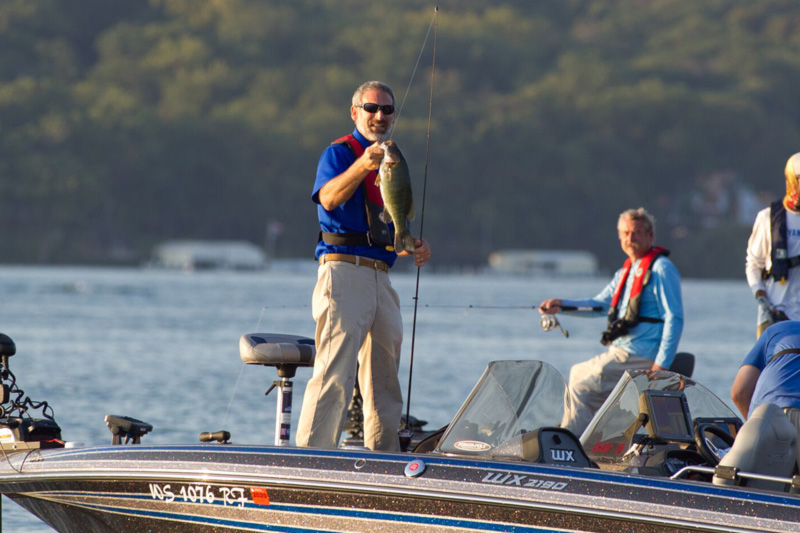Smallmouth bass may share some similarities with their relative, the largemouth bass, but don’t let that fool you when it comes to fishing for them yourself. You are most likely to find these fish in cool and clear streams running at moderate current where largemouth are less common, though smallmouth also will make their way out into large, clearwater lakes. For those interested anglers located near the major freshwater regions of the Shenandoah, Potomac, Susquehanna, and similar rivers, smallmouth bass are a common catch.

Adult smallmouth bass like to munch on crayfish, aquatic insects, and various small fish like perch and shiner. As for the babies, they feed on plankton and aquatic insects. Interestingly enough, these fish are also known to be cannibalistic if they are without a stable food source. Although native to the Great Lakes and Mississippi River basins, smallmouth bass made their way into Maryland after a B&O railroad employee transported them into the C&O canal. Regardless of location, these fish are sure to be a fan-favorite for any beginner fisherman out there.
Smallmouth Bass Identification
The smallmouth bass belongs to the Centrarchidae lineage, otherwise known as a member of the Sunfish family. These fish are expected to reach lengths of at least 12 inches into adulthood. This is what most states enforce as the legal harvestable size for smallmouth bass, too, although they’re most popular as a catch-and-release fish. If you spot a smallmouth out in the wild, it’s easiest to tell them apart from other bass due to their smaller size. Compared to largemouth bass that grow for nearly their entire life, smallmouth bass instead reach a maximum weight of about six to 10 pounds. The telltale sign to know you’ve caught a smallmouth bass is by the positioning of their upper jaw, which never extends beyond their eye unlike largemouth bass. They are also famous for their greenish-grey vertical bars that run down the sides of their body. With proportionately larger tails and stronger swimming muscles than largemouth bass, these fish are built for speed in strong currents and are great fighters when on the line.
Springtime is spawning season for smallmouth bass, where it is the male’s duty to ensure a safe and healthy environment for his eggs. He first shapes a nest in shallow water for the female to lay her eggs, then he fans the eggs to ensure adequate oxygen levels as well as guarding the nest from predators.
State Records for Smallmouth Bass
Gary Peters currently holds Maryland’s state record for smallmouth bass, where he reeled in an eight-pound two-ounce fish in 1974 from Liberty Reservoir. Virginia’s current-standing record holder is Donald S. Eaton, Jr. with his eight-pound one-ounce catch from New River back in 2003. From Delaware, Jerry Proffitt set the record for smallmouth bass in 1989 with his four-pound, 15.5-ounce catch.
Best Smallmouth Bass Baits
As mentioned earlier, smallmouth bass enjoy eating crayfish that they find in their habitat. So, they top the list. But they aren't the only option by a longshot. Smallmouth will eat:
- Crayfish
- Creek chub
- Redtail chub
- Nightcrawlers
- Leeches
- Minnows
Best Smallmouth Bass Lures
Not only do smallmouth bass bite at a variety of live baits, they also aren’t picky when it comes to the artificial lure you use. These fish love lures that imitate their favorite food groups, such as:
- Plugs
- Crankbaits
- Tube Jigs
- Soft plastic grubs and worms
Best Smallmouth Bass Fishing Techniques
Smallmouth bass fishing can be an exciting endeavor to novice fishermen, given their great fighting capabilities. Oftentimes when fishing large bodies of water, however, largemouth bass will beat smallies to nearly every offering. Fishing for smallmouth at either early or late points in the season can increase your chances of catching one, however, as they tend to be more active than largemouth bass at colder temperatures. Regardless of whether you prefer fishing for smallmouth bass in either rivers or lakes, keep in mind that jigging, fly fishing, and casting bait can all be effective. Since you’ll likely get tired from casting and catching fish all day (hopefully), using a light spinning or baitcasting tackle is recommended.
Popular Fishing Spots for Smallmouth Bass
Smallmouth bass enjoy finding water that holds moderate current, so they will frequent holes in streams and rivers. Since most of their prey cannot see that well during the early and late hours of the day, these are the times where smallmouth bass are most active. At their active points, these fish will stick close by their natural habitat of shallow, gravely river-bottom runs. They also like taking shelter behind rocks and boulders found along the shoreline. Deep pools of water are always good locations to investigate during either mid-day or summertime. Smallmouth bass enjoy hunting along the sides of steep drop-offs underwater, too. If it isn’t obvious, aim for areas that are dark (indicating deeper waters) and covered by debris for the best chances of catching smallies.
These fish are always on the move, so even after finding a sweet spot your luck can turn quickly. These fish are full of personality and aggression, however, so once you get one onto your line it's hard to stop fishing for them. For these reasons and more, smallmouth bass have become one of the most popular freshwater recreational fish among beginner and experienced anglers.
-By Cameron White